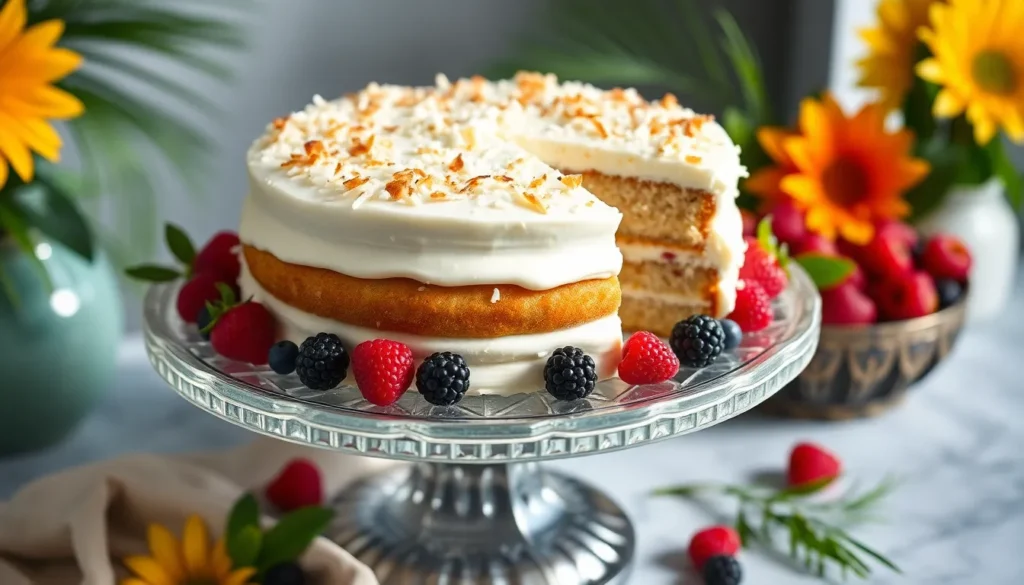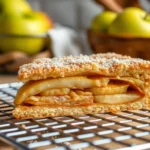We’ve all experienced that moment when coconut cake appears at a gathering and suddenly everyone’s priorities shift. There’s something utterly irresistible about layers of tender cake infused with tropical coconut flavor and topped with billowy frosting that’s been rolled in sweet coconut flakes.
Coconut cake transforms any ordinary day into a celebration. This Southern classic has been winning hearts for generations with its perfect balance of sweet and tropical flavors. The secret lies in using both coconut milk and shredded coconut to create depth that goes beyond just surface sweetness.
What makes our version special is how we’ve perfected the moisture level – no more dry disappointments that crumble at first bite. We’ll show you exactly how to achieve that coveted tender crumb while building layers of coconut flavor that’ll have everyone asking for your secret. Whether you’re planning a birthday celebration or simply craving something extraordinary this recipe delivers bakery-quality results right from your own kitchen.
Ingredients
Our coconut cake recipe combines premium ingredients to create the moist tender crumb and rich coconut flavor we promised. Each component plays a crucial role in delivering that bakery-quality texture and taste.
For the Cake
- 2¾ cups all-purpose flour
- 1 tablespoon baking powder
- 1 teaspoon salt
- ¾ cup unsalted butter, room temperature
- 1¾ cups granulated sugar
- 4 large eggs, room temperature
- 2 teaspoons vanilla extract
- 1 teaspoon coconut extract
- 1 cup canned coconut milk, full-fat
- ½ cup whole milk
- 1 cup sweetened shredded coconut
For the Coconut Cream Filling
- 1 cup heavy cream
- ½ cup powdered sugar
- ¼ cup coconut cream (thick layer from canned coconut milk)
- 1 teaspoon vanilla extract
- ½ teaspoon coconut extract
- ¼ cup sweetened shredded coconut
For the Coconut Buttercream Frosting
- 1 cup unsalted butter, room temperature
- 4 cups powdered sugar, sifted
- ¼ cup coconut cream
- 2 tablespoons heavy cream
- 1 teaspoon vanilla extract
- 1 teaspoon coconut extract
- ¼ teaspoon salt
For the Coconut Flake Topping
- 2 cups sweetened shredded coconut
- 1 cup unsweetened coconut flakes
- 2 tablespoons coconut oil, melted
- 1 tablespoon granulated sugar
Equipment Needed

Having the right tools makes all the difference when baking our coconut cake masterpiece. We need exact equipment to achieve that perfect texture and professional appearance that sets this cake apart from ordinary desserts.
Oven preparation requires preheating to temperatures between 320°F to 350°F (160°C to 177°C). This temperature range ensures even baking without compromising the cake’s moisture content.
Cake pans in 8-inch or 9-inch round sizes work best for this recipe. We recommend using light-colored aluminum pans for even heat distribution and consistent browning.
Mixing equipment includes either a stand mixer or handheld electric mixer for creaming butter and sugar effectively. The mixer creates the light, fluffy base that gives our coconut cake its signature texture.
Basic tools cover a wire whisk for combining dry ingredients and a rubber spatula for gentle folding motions. These tools help us maintain the cake’s delicate structure during preparation.
Parchment paper becomes essential for lining our cake pans. This simple step ensures easy cake release and prevents sticking that could ruin our carefully crafted layers.
Additional helpful items include measuring cups and spoons for accuracy, a large mixing bowl for combining ingredients, and a cooling rack for proper cake cooling. Wire cooling racks allow air circulation around the entire cake, preventing soggy bottoms.
Frosting tools such as an offset spatula or bench scraper help achieve smooth, professional-looking frosting application. These tools give us control over the final presentation of our coconut cake.
Instructions
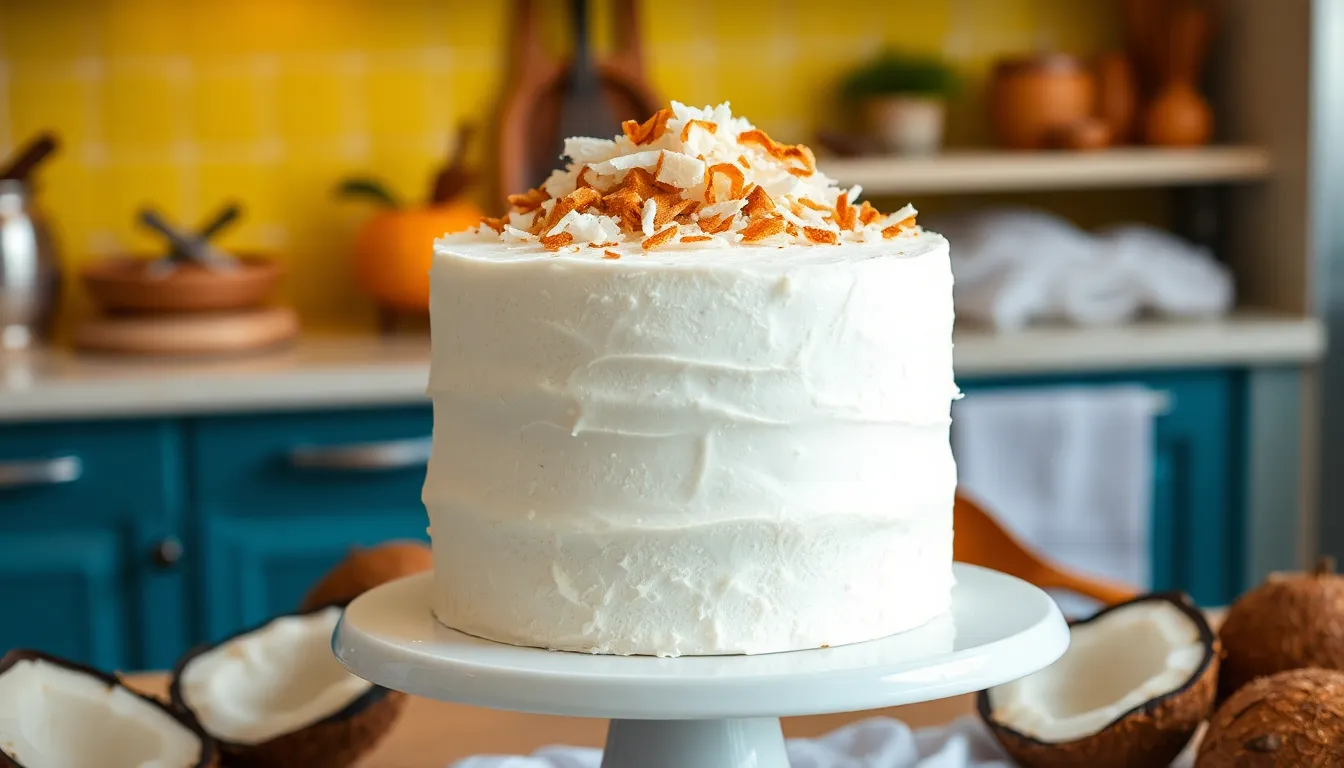
Follow these step-by-step instructions to create our perfect coconut cake with its signature moist texture and rich tropical flavor. We’ll walk you through each stage to ensure bakery-quality results.
Prep the Pans and Oven
Preheat your oven to 325°F for the most moist results. Grease two 8-inch round cake pans thoroughly with butter and dust with flour, tapping out any excess. Line the bottom of each pan with parchment paper to guarantee easy release after baking.
Make the Cake Batter
Whisk together flour, baking powder, salt, and cornstarch in a large mixing bowl until well combined. Set this dry mixture aside while we prepare the wet ingredients.
Cream the softened butter and granulated sugar in your stand mixer bowl using the paddle attachment for 3-4 minutes until light and fluffy. Add eggs one at a time, beating well after each addition. Pour in vanilla extract and coconut extract, mixing until incorporated.
Alternate adding the dry ingredients and coconut milk to the butter mixture, beginning and ending with the flour mixture. Mix on low speed until just combined after each addition. Stir in the whole milk until the batter is smooth. Gently fold in the sweetened shredded coconut using a rubber spatula to maintain the batter’s delicate structure.
Bake the Cake Layers
Divide the batter evenly between your prepared pans, smoothing the tops with an offset spatula. Bake for 30-33 minutes or until a toothpick inserted in the center comes out clean and the edges begin to pull away from the pan sides.
Cool the cakes in their pans for 15-20 minutes before turning them out onto wire racks. Allow the layers to cool completely before frosting, which typically takes 1-2 hours at room temperature.
Prepare the Coconut Cream Filling
Beat the coconut cream in a mixing bowl until smooth and creamy. Gradually add powdered sugar, beating until the mixture reaches your desired sweetness level. Stir in coconut extract to taste, starting with 1/2 teaspoon and adjusting as needed. The filling should be spreadable but hold its shape when piped.
Make the Coconut Buttercream Frosting
Beat the softened butter in your mixer bowl until light and fluffy, approximately 3-4 minutes. Gradually add powdered sugar one cup at a time, beating well after each addition. Pour in coconut cream and coconut extract, continuing to beat until the frosting is smooth and pipeable. The consistency should be creamy enough to spread easily but thick enough to hold decorative swirls.
Toast the Coconut Flakes
Preheat your oven to 325°F while your cake layers cool. Spread the coconut flakes in a single layer on a rimmed baking sheet. Toast for 5-10 minutes, stirring every 2-3 minutes to ensure even browning. Watch carefully as coconut can burn quickly. Remove when the flakes turn light golden brown and have a fragrant aroma.
Assembly Directions
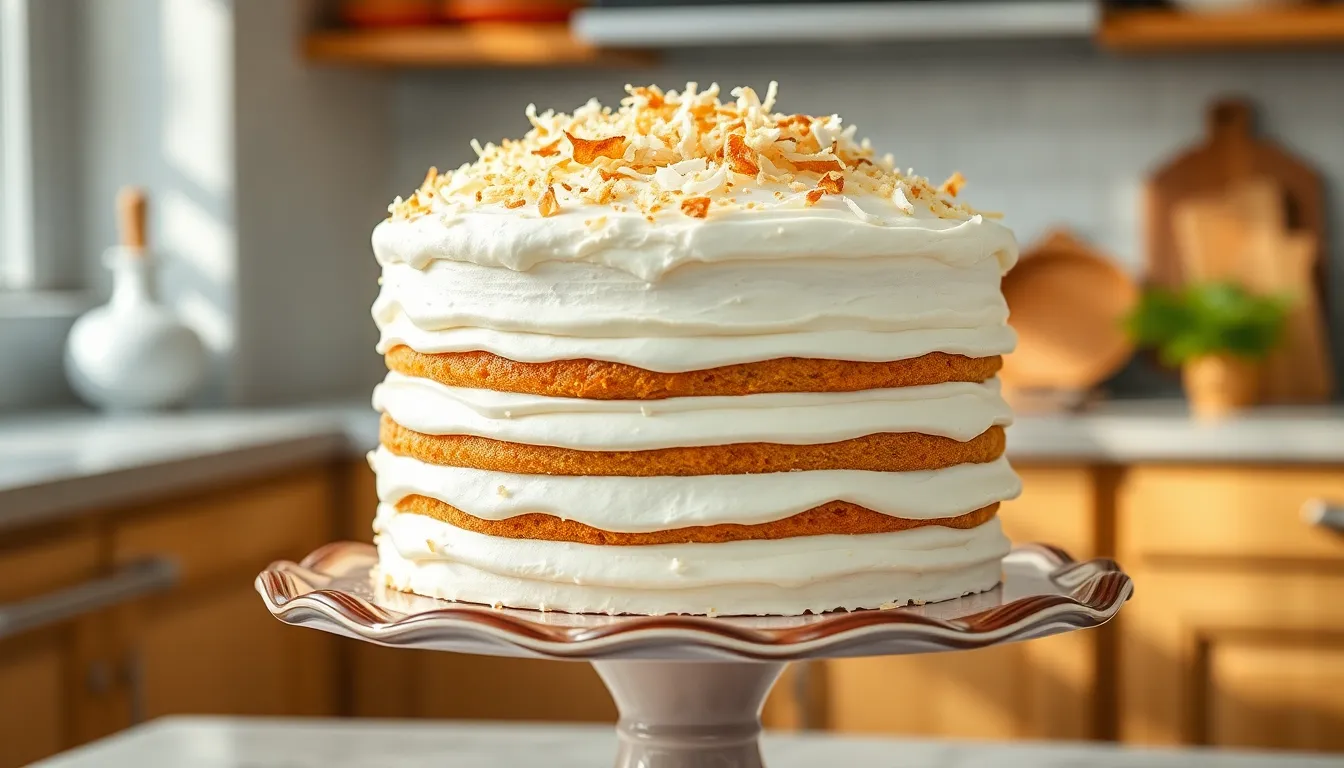
Now we bring together all our carefully prepared components to create the stunning final cake. These assembly steps ensure a professional appearance and perfect flavor distribution throughout every slice.
Layer the Cake
We start by placing our first completely cooled cake layer on a cake plate or cardboard round. A generous amount of coconut buttercream frosting gets spread evenly across the top surface using an offset spatula. The coconut cream filling adds another delicious layer of flavor when spread over the frosting. We center the second cake layer carefully on top and repeat this process if working with additional layers.
Level layers create the foundation for a professional looking result. Any domed or uneven surfaces should be trimmed with a serrated knife before stacking to achieve the best appearance.
Apply the Crumb Coat
The crumb coat serves as our foundation layer that seals in any loose crumbs before the final frosting application. We spread a thin layer of coconut buttercream over the entire exterior surface of our stacked cake using an offset spatula. Every surface needs coverage including the top and sides while keeping this coat deliberately thin and smooth.
Our cake needs to chill for at least 15 to 30 minutes after applying the crumb coat. This setting time allows the frosting to firm up and creates the perfect base for our final decorative layer.
Final Frosting and Decoration
The remaining coconut buttercream gets applied generously over our set crumb coat for the final frosting layer. We smooth the surface using a bench scraper or offset spatula to achieve that clean professional finish. The sides and top should have an even consistent coating of frosting.
Toasted coconut flakes provide the traditional finishing touch that makes coconut cake so visually appealing. We pat the toasted shredded coconut generously onto all frosted surfaces while the buttercream is still soft enough to hold the flakes. This coating enhances both the coconut flavor and creates an attractive textured appearance that defines classic coconut cake presentation.
Make-Ahead Instructions
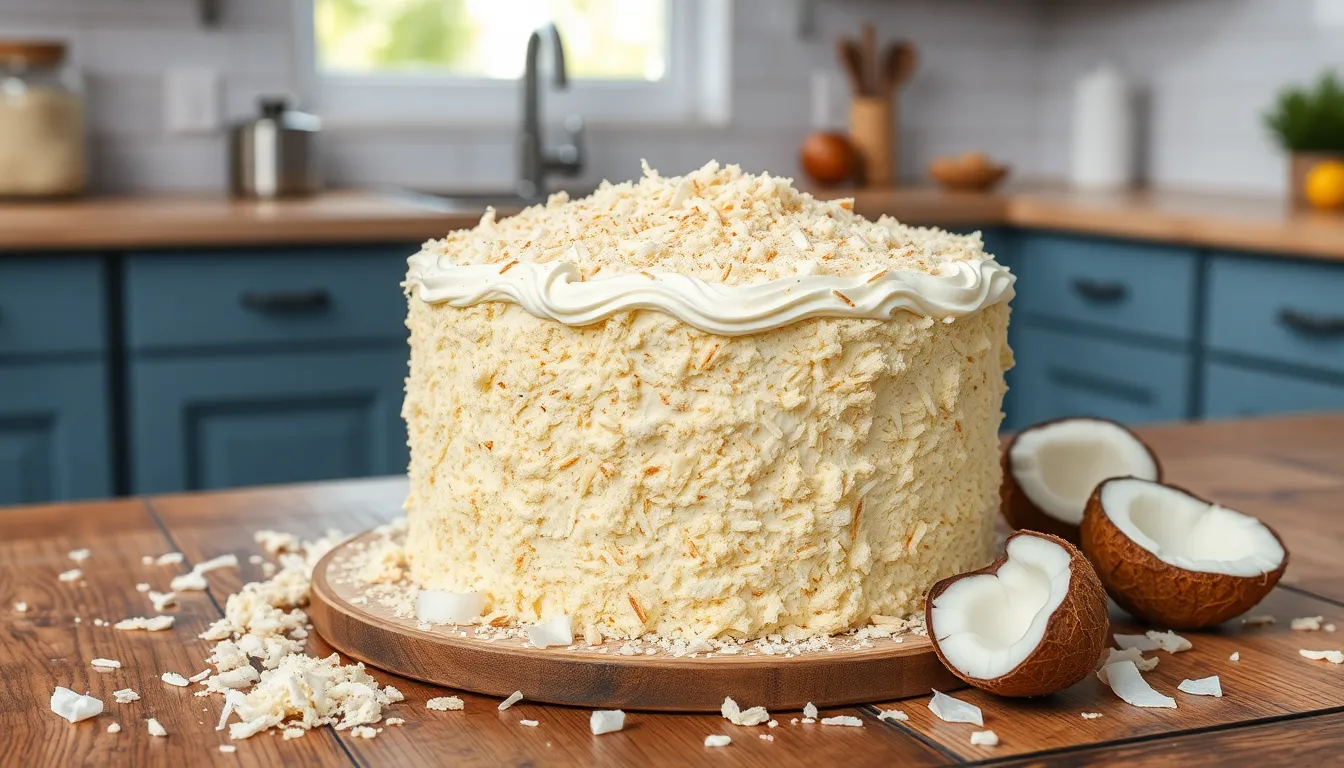
Planning ahead transforms coconut cake preparation from a last-minute rush into a stress-free experience. We’ve perfected several make-ahead strategies that maintain the cake’s signature moisture while giving you maximum flexibility for entertaining.
Preparing Cake Layers in Advance
Baked cake layers store beautifully for up to two weeks when properly wrapped. After the layers cool completely, we wrap each one tightly in plastic wrap to prevent moisture loss. Room temperature storage works perfectly for layers used within a few days, while freezing extends their freshness for longer periods. When you’re ready to assemble, simply thaw frozen layers at room temperature until they reach the ideal consistency for frosting.
Short-Term Storage Options
Overnight storage requires minimal effort for maximum convenience. We cover our cooled cake layers tightly and leave them at room temperature when planning to frost and assemble the next day. This method preserves the cake’s texture without requiring refrigeration space.
Extended Refrigerator Storage
Traditional recipes like the 3-Day Coconut Cake showcase the benefits of refrigerator storage for fully assembled cakes. We recommend refrigerating the completed frosted cake for up to three days, allowing the flavors to meld beautifully. The cake develops exceptional moisture and tenderness during this resting period. Proper coverage prevents the cake from drying out and maintains its bakery-fresh quality.
Advance Frosting and Filling Preparation
Both coconut buttercream frosting and coconut cream filling can be prepared ahead of schedule. We store these components separately in the refrigerator until assembly time. After putting the cake together, refrigerating for one to two days before serving produces optimal results. This approach works especially well for cakes containing perishable fillings or cream-based frostings.
Freezing the Complete Cake
The entire finished cake freezes successfully when wrapped properly. We use several layers of plastic wrap followed by storage in an airtight container to prevent freezer burn. Thawing overnight in the refrigerator restores the cake’s original texture and flavor profile perfectly.
| Storage Method | Duration | Best For |
|---|---|---|
| Room Temperature (wrapped layers) | 2-3 days | Quick assembly |
| Frozen Layers | Up to 2 weeks | Long-term planning |
| Refrigerated Assembled Cake | Up to 3 days | Flavor development |
| Frozen Complete Cake | Up to 1 month | Special occasions |
These strategic make-ahead approaches simplify your baking schedule while ensuring consistent, professional results every time you serve this beloved coconut cake.
Storage Tips
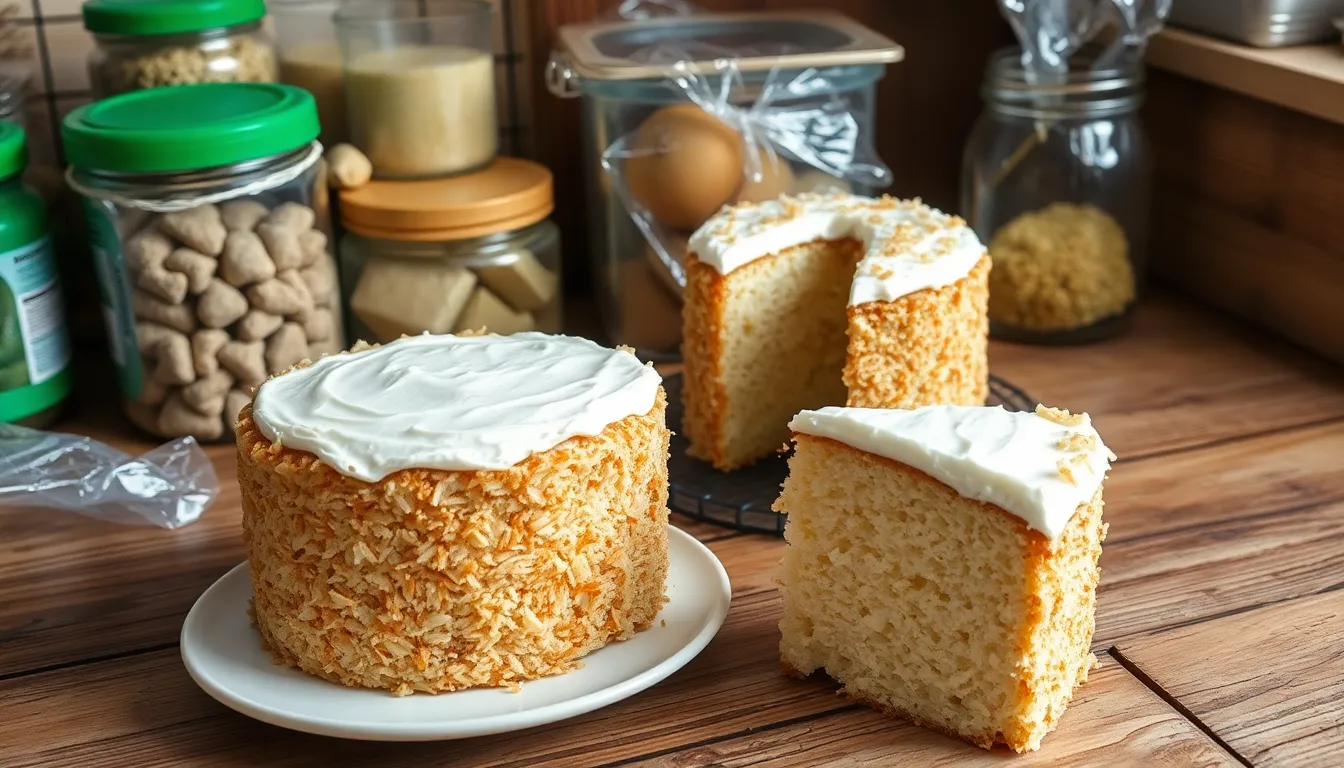
Proper storage preserves your coconut cake’s moisture and flavor while preventing spoilage. We’ll share the best methods to keep your cake fresh for days or even months.
Room Temperature Storage
Store your coconut cake loosely covered at room temperature when your kitchen stays at 70°F or below. The cake maintains its quality for up to two days using this method. Keep the cake away from direct sunlight and heat sources to prevent premature spoilage. This approach works best for cakes that will be consumed quickly.
Refrigeration Methods
Refrigerate your coconut cake when storing it for more than two days. The cake stays fresh in the refrigerator for 5 to 7 days when properly stored. Use a sealed container to maintain moisture levels and prevent the cake from absorbing other food odors. Refrigeration extends the cake’s life significantly while preserving its delicate coconut flavors.
Freezing Options
We recommend different freezing techniques based on whether your cake is frosted or unfrosted.
Unfrosted cake layers require tight wrapping in plastic wrap followed by aluminum foil before placing in an airtight container or freezer bag. These layers maintain their quality for 2 to 5 months in the freezer.
Frosted cakes need initial freezing on a cookie tray for about 4 hours until solid. Wrap the solid cake in plastic wrap and store in an airtight container or freezer bag for up to 5 months.
Individual slices offer convenient portion control when frozen separately. Place slices on a parchment-lined baking sheet and freeze for 1 to 2 hours. Wrap each frozen slice in plastic wrap and store in a zip-top freezer bag for up to one month.
Spoilage Detection
Check your coconut cake regularly for signs of deterioration to ensure food safety. Look for visible mold appearing as greenish-blue spots on the surface or edges. Smell the cake for any sour or unpleasant odors that indicate spoilage. Taste a small portion if visual and smell tests pass but discard the cake immediately if it tastes stale or off.
| Storage Method | Temperature | Duration | Container Type |
|---|---|---|---|
| Room Temperature | 70°F or below | 2 days | Loosely covered |
| Refrigeration | 35-40°F | 5-7 days | Sealed container |
| Freezer (Unfrosted) | 0°F | 2-5 months | Airtight container/freezer bag |
| Freezer (Frosted) | 0°F | Up to 5 months | Airtight container/freezer bag |
| Freezer (Slices) | 0°F | 1 month | Zip-top freezer bag |
Serving Suggestions
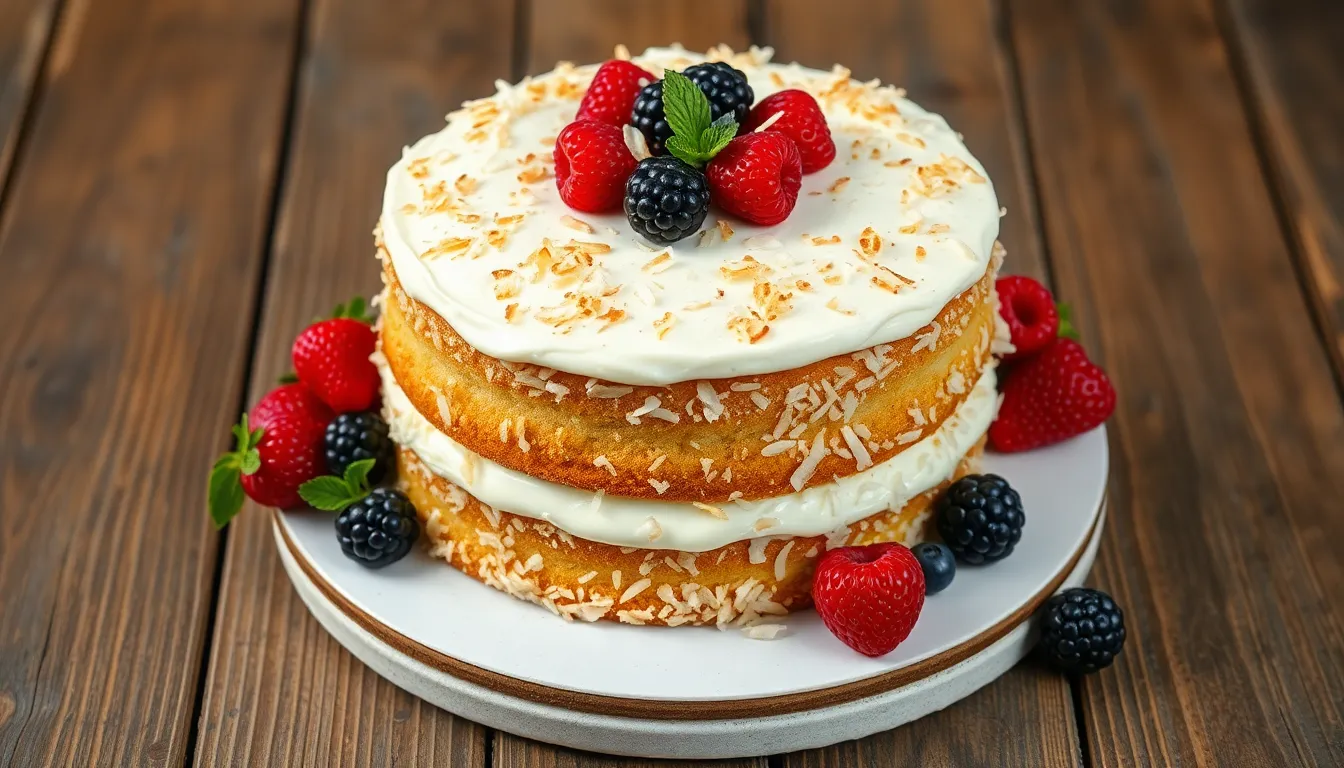
We recommend serving our coconut cake at room temperature for the best flavor and texture experience. Allowing the cake to rest outside the refrigerator for 30-45 minutes before serving enhances the coconut flavors and creates the perfect creamy frosting consistency that melts beautifully on your tongue.
The classic presentation involves pairing our coconut layers with coconut cream cheese frosting for a rich and tangy complement to the sweet cake. Coconut Swiss meringue buttercream offers another elegant option that creates silky smooth layers between each cake tier. We love how these traditional frostings highlight the natural coconut essence without overwhelming the delicate crumb.
For those seeking fruity variations, we suggest incorporating lemon curd between layers to add bright citrus notes that balance the rich coconut flavors. Raspberry filling creates a beautiful color contrast while providing tart sweetness that cuts through the cake’s richness. Pineapple filling transforms our coconut cake into a tropical paradise that transports you to sunny beaches with every bite.
We always finish our presentation by sprinkling toasted coconut flakes generously on the sides and top of the frosted cake. This decorative touch adds textural interest and visual appeal while intensifying the coconut flavor profile. The golden brown flakes create an irresistible crunch that contrasts beautifully with the soft cake layers.
Berry compote serves as an exceptional accompaniment when drizzled alongside individual slices. The tart berries provide a refreshing counterpoint to the sweet coconut elements while adding vibrant color to your dessert plate. We recommend preparing the compote separately so guests can customize their serving according to their taste preferences.
Conclusion
We’ve shared everything you need to create a stunning coconut cake that’ll become your go-to dessert for any celebration. From the essential ingredients to the step-by-step assembly process our guide ensures you’ll achieve that perfect balance of moist texture and rich coconut flavor every time.
The beauty of this recipe lies in its flexibility and make-ahead options. Whether you’re planning for a special occasion or satisfying a sudden craving you now have the tools and techniques to create a bakery-quality coconut cake from your own kitchen.
Remember that proper storage and serving techniques will maximize your cake’s flavor and presentation. With these tips in your arsenal you’re ready to impress family and friends with a dessert that captures the essence of tropical indulgence in every bite.
Frequently Asked Questions
What makes coconut cake so special?
Coconut cake is a beloved Southern classic that combines tropical flavors with fluffy frosting. Its perfect balance of sweetness and depth comes from coconut milk and shredded coconut, creating a moist, tender crumb that elevates any gathering with its distinctive taste and texture.
What are the main ingredients needed for coconut cake?
The essential ingredients include all-purpose flour, baking powder, salt, unsalted butter, granulated sugar, eggs, vanilla extract, coconut extract, coconut milk, whole milk, and sweetened shredded coconut. You’ll also need ingredients for coconut cream filling, buttercream frosting, and coconut flake topping.
What equipment do I need to bake a perfect coconut cake?
You’ll need light-colored aluminum cake pans, a stand mixer or handheld electric mixer, wire whisk, rubber spatula, measuring cups, large mixing bowl, cooling rack, and parchment paper. For frosting, use an offset spatula or bench scraper for professional-looking results.
What’s the ideal baking temperature for coconut cake?
Preheat your oven to 325°F for even baking. Some recipes may call for temperatures between 320°F to 350°F, but 325°F ensures consistent results with proper heat distribution throughout the cake layers without over-browning the exterior.
How do I assemble a layered coconut cake properly?
Start with cooled cake layers on a plate. Level any domed surfaces, then spread coconut buttercream and cream filling between layers. Apply a crumb coat to seal crumbs, chill, then add final frosting layer. Top with toasted coconut flakes for decoration.
Can I make coconut cake ahead of time?
Yes! Baked layers can be stored for up to two weeks when properly wrapped at room temperature or frozen. Frosting and filling can be prepared in advance. Fully assembled cakes can be refrigerated for enhanced flavor and moisture, or frozen for special occasions.
How should I store coconut cake to keep it fresh?
Store at room temperature loosely covered for up to 2 days. Refrigerate in sealed containers for 5-7 days. For freezing, wrap unfrosted layers tightly (2-5 months) or freeze frosted cakes after solidification (up to 5 months). Individual slices freeze well for portion control.
What’s the best way to serve coconut cake?
Serve at room temperature for optimal flavor and texture. Pair with coconut cream cheese frosting or Swiss meringue buttercream. Consider adding lemon curd, raspberry filling, or pineapple filling for fruity variations. Garnish with toasted coconut flakes and berry compote.
How can I tell if my coconut cake has gone bad?
Check for visible mold, unpleasant odors, or off-tastes. Fresh coconut cake should smell sweet and coconutty. If you notice any sour smells, unusual textures, or discoloration, discard the cake immediately to ensure food safety.
Why does my coconut cake turn out dry?
Dry coconut cake often results from overbaking or incorrect measurements. Use coconut milk instead of regular milk for extra moisture, don’t overmix the batter, and check doneness with a toothpick. Proper storage and serving at room temperature also helps maintain moisture.

